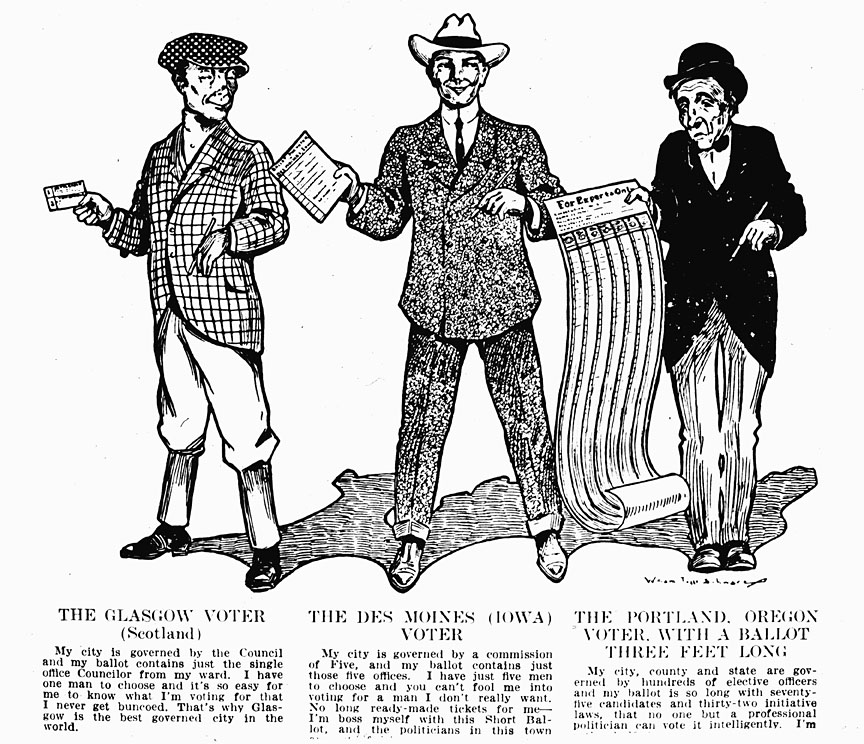- Catalog No. —
- OrHi 11457
- Date —
- 1912
- Era —
- 1881-1920 (Industrialization and Progressive Reform)
- Themes —
- Government, Law, and Politics
- Credits —
- Oregon Historical Society
- Regions —
- None
- Author —
- William Toffe Schwarz
Oregon System Cartoon
This political cartoon from Joseph Gaston’s Centennial History of Oregon depicts a befuddled Portland voter holding a lengthy ballot in one hand standing next to two other men who hold much simpler ballots and sport more upbeat expressions. The cartoon refers to concerns about the increasing length and complexity of Portland ballots in 1912. Opponents of Progressive voting reforms felt that Oregon’s Initiative and Reform system complicated the ballot and confused voters, in turn degrading the quality of the electoral process in Oregon.
Between 1902 and 1914, Oregon voters passed a series of progressive election reforms that transformed the state’s political system by increasing citizen participation through direct legislation. Collectively known as the “Oregon System,” these reforms: amended the state’s constitution to allow citizens to put measures on the ballot by using initiative and referendum; created direct primaries; expanded the initiative and referendum to local and municipal levels; and granted voters the power to recall public officials. The initiative and referendum process let citizens submit measures on the state ballot if they had collected enough voter signatures on a petition. The scope of these election and political reforms returned a measure of political power back to Oregon voters and helped counter the influence of corporations in Oregon’s political process.
The “Oregon System” did have some unintended consequences. Both opponents and proponents were caught off-guard by the number of measures that qualified for the ballot—thirty-four in 1912 alone. Not only did this make ballots more confusing and complex, but it also raised concerns about the ability of voters to be fully informed about each measure. Reformers had envisioned that the initiative and referendum would be used only in matters of great importance, but by 1914, voters had faced sixty constitutional amendments and seventy-six statutory measures. Proposals to limit the numbers of measures allowed per ballot met immediate opposition. So did the idea that the legislature review and approve proposed referendums prior to being placed on the ballot. Only the onset of World War I and the end of the Progressive Era helped stem the glut of ballot measures in Oregon.
The 1990s saw a resurgence in the use of the initiative and referendum and a corresponding rise in the complaints about its use. Critics charged that the high cost of the process was out of proportion to the return to the voters; that allowing voters to alter the state’s constitution posed a threat to the overall welfare of the state; that poorly planned ballot measures resulted in people voting against their interests; that the petition system is open to fraudulent signatures and other manipulations. Any efforts to change the initiative and referendum still meet with strong opposition.
Further Reading:
Barnett, James D. The Operation of the Initiative, Referendum and Recall in Oregon. New York: 1915.
Eaton, Allen H. The Oregon System: the Story of Direct Legislation in Oregon. Chicago: 1912
Evans, Tony Howard. Oregon Progressive Reform, 1902-1914. University of California Ph.D. Dissertation: 1966.
Written by Sarah Griffith, Dane Bevan, © Oregon Historical Society, 2002, 2004.
